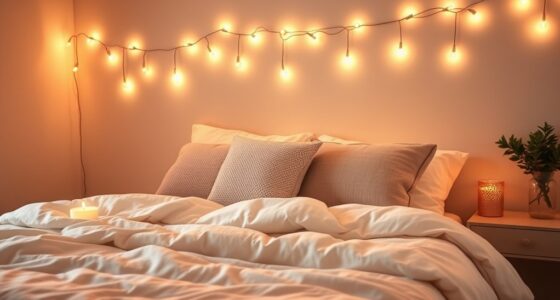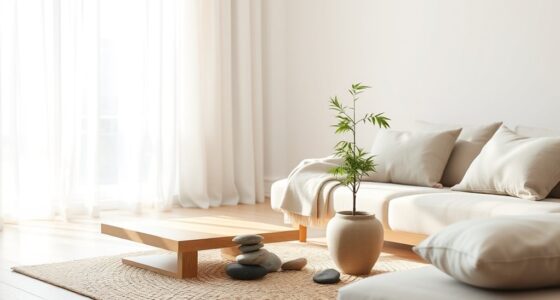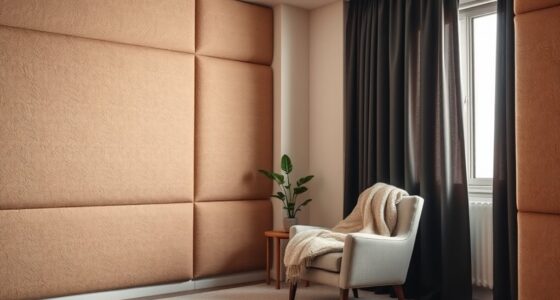Painting your room with carefully chosen colors can effectively influence your mood and emotional well-being. Warm hues like red and orange boost energy and excitement, while cool tones such as blue and green promote calmness and relaxation. Using soothing pastel shades or neutrals creates a peaceful environment that reduces stress. Since colors impact emotions and behavior, your environment’s palette plays an essential role. Continue exploring to discover how specific shades can transform your space and lift your spirits.
Key Takeaways
- Colors influence emotions and behaviors, with warm tones energizing and cool tones promoting relaxation.
- Selecting calming colors like blue and green can reduce stress and enhance mood.
- The saturation and symbolism of colors affect perception and emotional response in a space.
- Thoughtful color choices in room design can foster mental well-being and emotional balance.
- Combining color with environment elements like sound and texture amplifies mood-enhancing benefits.
Understanding the Basics of Color Psychology

Color psychology explores how different colors influence your emotions and behaviors. You should understand that color symbolism plays a key role in this, as certain hues carry specific meanings across cultures—red often signifies passion, while blue can evoke calmness. Additionally, color saturation impacts your perception; vibrant, highly saturated colors tend to energize you, whereas muted tones promote relaxation. Recognizing these elements helps you grasp how colors can shape your mood intentionally. When choosing paint for your space, consider both the symbolism and saturation levels to create an environment that aligns with your desired emotional state. Furthermore, understanding the plant properties of colors can help you select shades that promote specific feelings and behaviors, making your space more conducive to your well-being. By understanding these basics, you can harness the power of color to positively influence your feelings and behavior.
How Different Colors Affect Emotions and Behavior

You might notice that warm colors like red and orange boost your energy and create a sense of excitement. In contrast, cool colors such as blue and green tend to promote relaxation and calmness. Understanding these effects can help you choose colors that influence your mood and behavior intentionally. Additionally, just as WWE Raw’s financial impact surpasses that of some countries’ GDP, the colors we choose can significantly influence our mental and emotional “wealth.”
Warm Colors Energize
Warm colors like red, orange, and yellow have a powerful ability to energize and stimulate the mind and body. In color psychology, these hues are linked to increased activity, enthusiasm, and warmth. When you paint your room with warm colors, you create an energetic room ambiance that can boost motivation and positivity. These shades tend to elevate your mood and encourage social interaction, making them ideal for spaces where you want to promote activity and engagement. Keep in mind, though, that too much red might feel overwhelming, so balance is key. Using warm colors strategically can help you harness their energizing effects, transforming your space into an uplifting environment that influences your emotions and behavior in a positive way. Incorporating crochet styles for locs can also add a creative and personalized touch to your space, reflecting your vibrant personality.
Cool Colors Calm
Have you ever noticed how certain shades can instantly bring a sense of tranquility or relaxation? Cool colors like blue, green, and violet are known to calm your mind and reduce stress. Many believe in color therapy myths that these shades automatically improve mood, but the truth is more nuanced. Room color trends now focus on creating peaceful environments, especially in bedrooms and workspaces. Incorporating sustainable design practices can further enhance the calming effects of these colors while also supporting eco-friendly living.
- Blue hues can lower blood pressure and promote focus
- Soft greens evoke harmony and balance
- Lavender shades help ease anxiety
- Cool tones are often used to create soothing atmospheres
- Choosing the right shade depends on personal preference and room purpose
The Science Behind Chromotherapy and Its Effectiveness
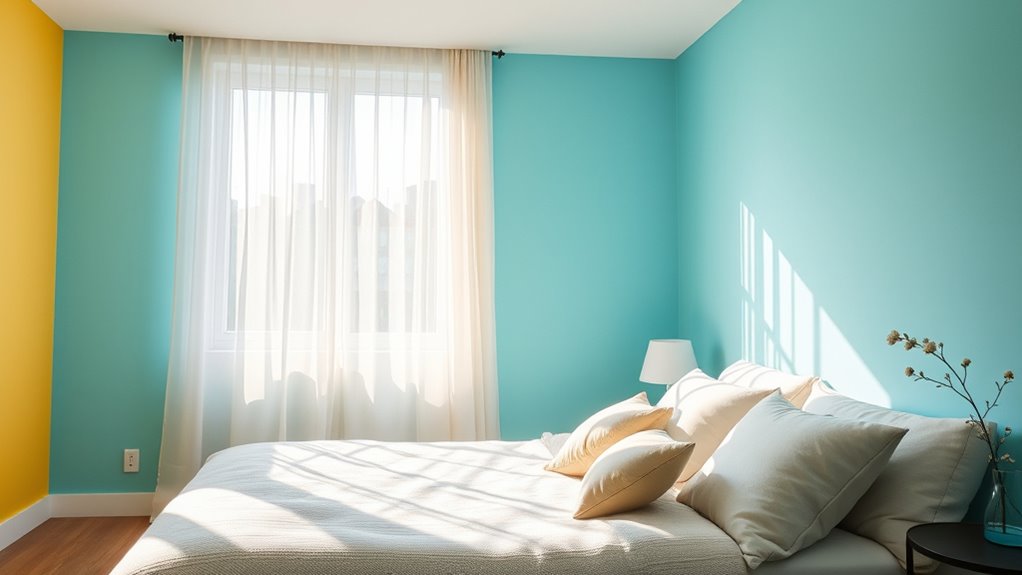
While scientific research on chromotherapy remains limited, some studies suggest that exposure to specific colors can influence mood and physiological responses. This forms the basis of color therapy, which aims to harness hues to promote well-being. When you transform your room’s color scheme, you may experience subtle shifts in your emotions and stress levels. Although concrete scientific proof is still emerging, researchers believe that colors can trigger responses in the brain, affecting heart rate, blood pressure, and hormonal activity. This connection supports the idea that room transformation through strategic color choices could serve as a complementary tool for mood regulation. Additionally, color perception involves complex interactions between visual stimuli and brain activity, highlighting the potential for intentional color use to influence mental states. While more rigorous research is needed, current findings hint that color therapy might offer a simple, accessible way to impact your mental state positively.
Popular Colors for Enhancing Mood and Their Benefits
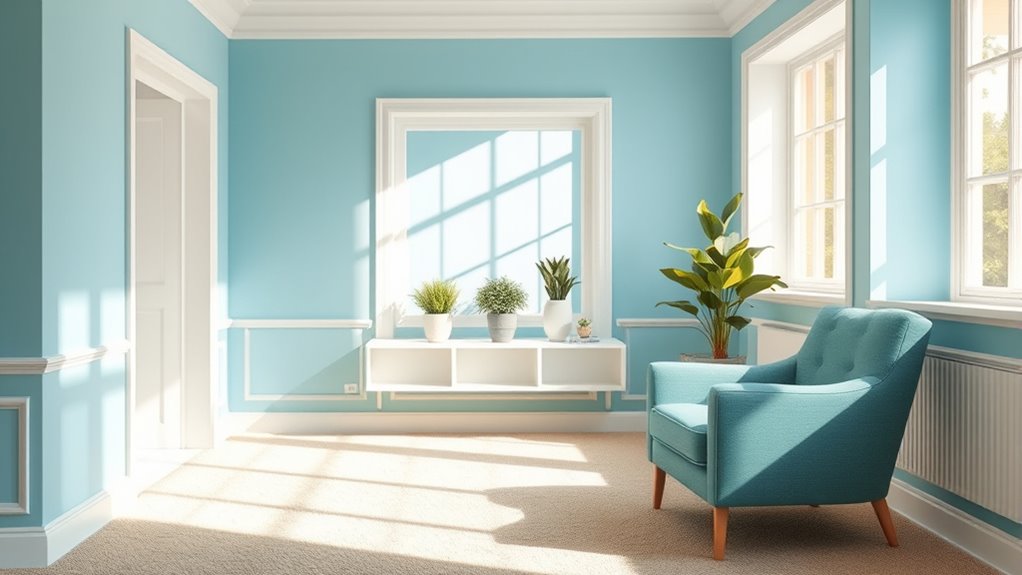
Colors can crucially influence your mood, so choosing the right ones matters. Calming blues and greens promote relaxation, while energizing reds and oranges boost your vitality. Serene neutrals and pastels create a peaceful atmosphere that helps you unwind. Additionally, incorporating color therapy elements into your space can further enhance your emotional well-being.
Calming Blues and Greens
Calming blues and greens are among the most popular colors used in therapy to promote relaxation and reduce stress. These hues evoke tranquility through their strong color symbolism and cultural color meanings, which often associate them with nature and peace. When you choose blue or green for your space, you create a soothing environment that encourages calmness and focus. Incorporating these colors can also be a strategic way to monitor social media giveaways, helping you stay informed about promotional offers that can enhance your space without additional costs.
- Blue symbolizes trust, serenity, and stability, helping to ease anxiety.
- Green represents growth, harmony, and renewal, fostering balance.
- Both colors are linked to nature, reinforcing feelings of safety and comfort.
- These hues are versatile, fitting well in bedrooms, offices, or meditation areas.
- Using calming blues and greens can positively influence your mood and overall well-being.
Energizing Reds and Oranges
Energizing reds and oranges are powerful choices for boosting your mood and increasing motivation. These colors carry strong color symbolism, often representing excitement, passion, and energy. In many cultures, red symbolizes luck, strength, and vitality, while orange is associated with warmth, enthusiasm, and creativity. Incorporating these hues into your space can stimulate your senses and promote a lively atmosphere. Reds and oranges can help combat feelings of fatigue or sluggishness by encouraging action and alertness. Be mindful of cultural color meanings, as they can influence how the colors are perceived—reds might evoke passion or aggression, and oranges might feel inviting or overwhelming. Used thoughtfully, these vibrant shades can transform your environment into a motivating and invigorating space. Additionally, understanding color psychology can help you select shades that support your desired emotional response effectively.
Serene Neutrals and Pastels
While vibrant reds and oranges boost energy, shifting to serene neutrals and pastels creates a tranquil environment that promotes relaxation and mental clarity. These soft hues embody calming color symbolism, fostering a sense of peace and stability. Pastels like blush pinks, gentle blues, and mint greens promote aesthetic harmony, making your space feel balanced and inviting. They help reduce stress and encourage mindfulness, ideal for bedrooms or meditation areas. These colors aren’t just soothing; they also reflect subtle elegance and simplicity. Using neutrals and pastels can enhance your mood by providing a quiet backdrop that supports focus and emotional well-being. Incorporating ambient sounds into your space can further enhance this serene atmosphere, fostering a sense of calm and relaxation. Carefully selecting these shades and sounds creates a harmonious environment that nurtures your mental health and promotes overall harmony in your living space.
Tips for Choosing the Right Palette for Your Space

Choosing the right color palette for your space can substantially influence its mood and functionality. Start by considering the overall atmosphere you want to create—calm, energetic, cozy, or inspiring. Balance your main colors with decorative accents, like cushions or artwork, to add personality without overwhelming the room. Pay attention to lighting design, as natural and artificial light can alter how colors appear, so test paint swatches at different times of day. Keep in mind the room’s purpose; soothing hues work well in bedrooms, while vibrant shades suit creative spaces. Stick to a cohesive color scheme, but don’t be afraid to incorporate complementary or accent colors for visual interest. Using color psychology can help you select hues that evoke the desired emotions and enhance your space’s mood. With thoughtful choices, your palette can transform your space into a mood-enhancing haven.
Personal Stories and Research Findings on Color and Well-Being
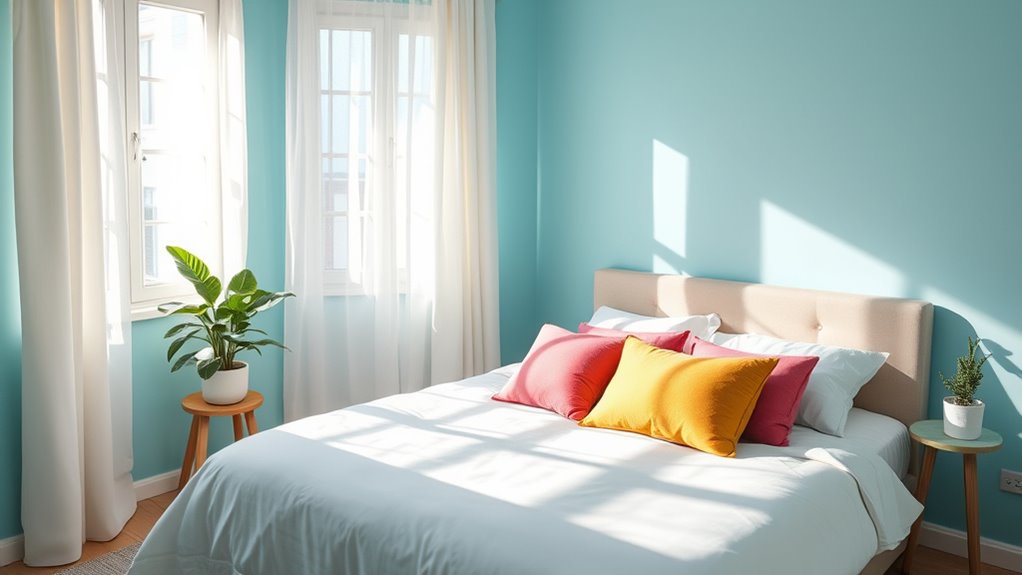
Numerous studies and personal stories reveal that color choices can substantially impact your mood and overall well-being. Many individuals share color therapy success stories, highlighting how selecting hues aligned with personal color preferences can boost happiness and reduce stress. These stories often emphasize the power of subtle changes, like painting a wall a favorite shade or incorporating calming tones. Research supports this, showing that blue hues promote relaxation, while vibrant reds energize. Personal experiences reveal that embracing colors you love fosters a sense of comfort and positivity.
- Personal color preferences influence how you feel daily
- Color therapy success stories inspire confidence in hues’ effects
- Bright colors can elevate your mood quickly
- Soft tones promote calm and focus
- Your color choices shape your overall well-being
Practical Steps to Transform Your Room With Mood-Boosting Hues
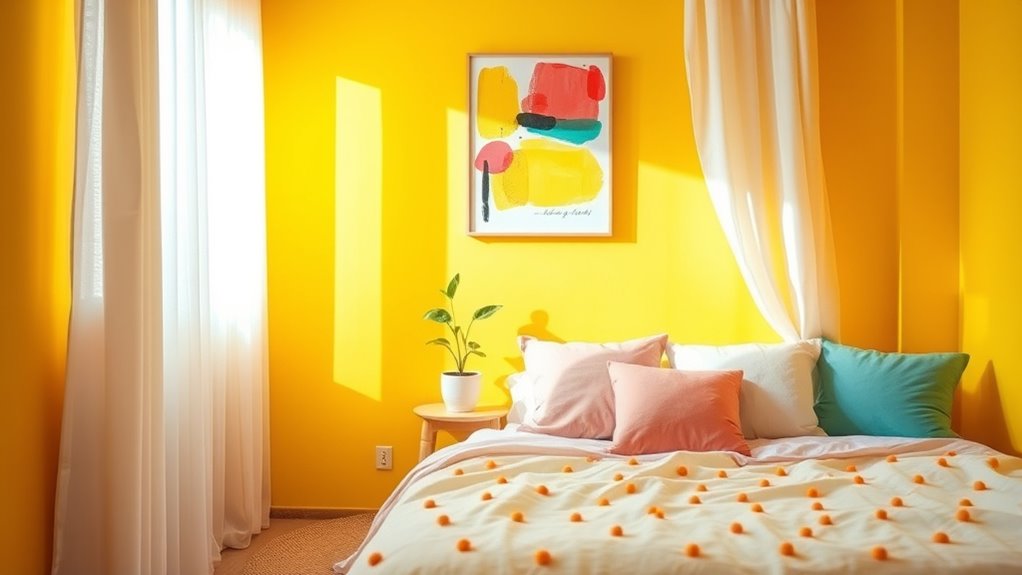
Transforming your room with mood-boosting hues is a practical way to enhance your well-being and create a space that reflects your emotional needs. Start by choosing color combinations that evoke the feelings you want to cultivate—calm blues, energizing yellows, or soothing greens. Consider how different paint textures can add depth and dimension; matte finishes create a cozy, relaxed atmosphere, while satin or semi-gloss textures add brightness and energy. Before painting, test small patches to see how natural light influences the colors. Use painter’s tape for clean lines and plan your color scheme to balance bold accents with neutral tones. With thoughtful selection of hues and textures, you’ll craft a space that not only looks good but also supports your mood and mental health.
Frequently Asked Questions
Can Color Therapy Replace Traditional Mental Health Treatments?
You might wonder if color therapy can replace traditional mental health treatments, but it’s important to understand common misconceptions. While painting your room with calming colors can boost your mood, it shouldn’t replace professional help. Use paint selection tips like choosing soothing hues and avoiding overly bright shades. Remember, color therapy complements treatment, but it isn’t a substitute for therapy or medication when needed.
Are There Any Risks Associated With Certain Paint Colors?
When considering paint safety and color psychology, you should be aware of potential risks. Some colors may trigger unwanted emotions, like intense reds causing agitation. Also, make certain you choose low-VOC or non-toxic paints to avoid health issues. While color psychology can influence your mood positively, using the wrong shades or unsafe paints might cause stress or allergic reactions. Always research paint safety and select colors that promote calm and comfort.
How Long Does It Take to Notice Mood Changes From Color Changes?
Imagine your mind as a garden, constantly adapting like spring blooms. When you paint your room a new color, your psychological adaptation begins instantly. You might notice immediate effects, such as a boost of energy or calmness, within hours or days. Usually, mood changes become noticeable within a few days to a week, as your subconscious absorbs the new environment and begins to influence your feelings.
Do Cultural Differences Influence Color Perceptions and Effects?
Cultural differences definitely influence how you perceive colors and their effects. You might associate red with luck in some cultures, while others see it as aggressive. Cultural symbolism shapes your color associations, impacting your mood and reactions. So, when choosing colors, consider these cultural nuances to guarantee your environment positively influences your emotions and aligns with your personal or cultural symbolism.
Can Lighting Impact the Effectiveness of Color Therapy in a Room?
Lighting influence plays a pivotal role in how color therapy works in your room. The right lighting can enhance ambiance effects, making colors appear warmer or cooler, which impacts your mood. Bright, natural light boosts energy and positivity, while softer, dimmer lighting creates a calming atmosphere. So, adjusting your lighting helps maximize the benefits of your room’s colors, ensuring you get the desired emotional and psychological effects.
Conclusion
Changing your room’s colors can remarkably boost your mood—studies show that up to 70% of people report feeling happier in color-optimized spaces. By choosing the right hues, you can create an environment that promotes relaxation, motivation, or creativity. So, why not experiment with color therapy? A simple paint job or accessories can transform your space—and your well-being—making every day a little brighter and more positive.



